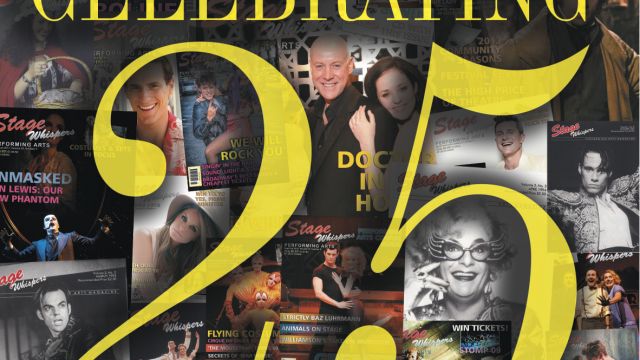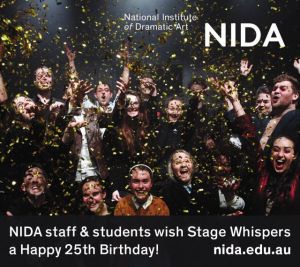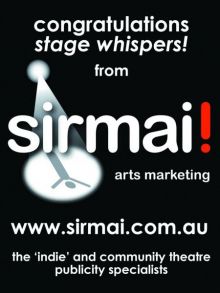Twenty Five Years of Stage Whispering
Apart from our logo, Stage Whispers magazine is barely recognisable from its humble origins in 1991 as a black and white newspaper - a voice of amateur theatre. Just as the magazine has changed, so has the theatre world it reports on. *David Spicer spoke to some leading lights in the professional and community theatre worlds to reflect on the last quarter of a century.
The first quote in the first edition of Stage Whispers Magazine was a knock out.
“Never ask a Drag Queen his age,” Daniel Abineri said, speaking about his role of Frank-N-Furter in The Rocky Horror Show.
Stage Whispers, born in 1991 in the Melbourne suburb of Emerald, proudly admits to its age as it turns 25.
Over the years the magazine has interviewed a Who’s Who of Australian Show Business.
Many famous faces have graced the covers. As you can see, the cover ‘models’ have included Hugh Jackman, David Atkins, Todd McKenney, John Bell, Geoffrey Rush, Anthony Warlow, Nancye Hayes and Barry Otto.
Leading theatre producer John Frost has had more of his shows on the cover than any other. He reflects on the explosion in audience numbers since the magazine was founded.
“All the work that people like Cameron Mackintosh did during the 80’s … the seeds have been sown and now they are starting to bloom,” he said.
“We are now seeing parents bringing their kids up and taking them to the theatre. Yes they learn swimming, football, play the violin but it is cool now to go to theatre.”
Leading lady Caroline O’Connor agrees.
“In the early 80’s there might be three musicals a year. Now there is a greater variety produced and touring and put into theatres for short runs.”
She also notes a change in attitude from young people in the industry.
“In my day you never got an opportunity ‘off the bat’. You needed more experience before playing a role. Now people are less patient. It puts incredible pressure on someone not in the business for very long, as it is very demanding performing eight shows a week.”
Many community theatre identities also graced the cover over the years. This is because the magazine was first pitched as the voice of amateur theatre.
The first edition, an A3 sized black and white newspaper of 24 pages, hit the streets of Melbourne with a cover price of $2.00. The front page featured three actors from the production Ratz Tales by the Tin Alley Players.
Another story had the headline “The Show Must Go On”. That was the cry from the Lilydale Athenaeum Theatre, a week after a deliberately lit fire caused $100,000 damage. Thankfully a burglar alarm allowed the building and its historic Dame Nellie Melba collection to be saved.
Community Theatre has changed since 1991. The Cheltenham Light Opera Company in suburban Melbourne became CLOC.
The current Treasurer Grant Alley OAM says many of the family oriented community theatre companies around at the time that staged ‘older’ works have disappeared.
“There is a significant rise in audience expectations on the calibre of cast. We require triple threats. 25 years ago there was your ballet, principals and chorus. Now everyone on stage is a principal.”
Grant Alley is referring to the melting pot of Greater Melbourne, where there is intense competition amongst community theatre companies.
“We have moved from companies being run by a group of enthusiasts, to a group of producers on committees with most of the rest of the cast/production team transient.”
He says more older style theatre companies still operate in the outer suburbs and regional areas where they are captive to “venues who screw them”.
In Sydney, the President of the Willoughby Theatre Company Tom Sweeney agrees that audiences are demanding a higher level of professionalism.
WTC has moved from a community hall to a fully equipped proscenium theatre with an orchestra pit and fly tower.
“Audiences expect more of what they see on TV. The line between amateur and professional theatre is blurring. People are expecting what they want for half the price. We meet that as best we can on our budget.”
Adding to the blurring of lines is the growth of pro-am theatre. Companies in Canberra (Free Rain), Sydney (Packemin) and Brisbane (Harvest Rain) are blending professional and amateur casts.
In his first editorial, Jeff Jones wrote that “playing editor means not much sleep, more grey hair and the need to install a telephone answering machine.”
A magazine in those pre-internet days needed a central office. Artwork had to be physically received. Today the Editor of Stage Whispers (Neil Litchfield) lives in Sydney, while our layout guru Phil Tyson and advertising manager Angela Thompson live in Melbourne. The same team putting the magazine together since 2008 has never been in the one place together.
Stage Whispers now has a much larger readership that ever before. There are 60,000 unique visitors a month to our website, while many more people see the cover of our magazine on a Facebook page than at a newsagent.
Publicist Ian Phipps says social media has “changed the way of marketing shows totally.”
“We reach people directly - advertising is a lot less important or effective. Social media is the way people find out about shows and you get immediate reaction.”
But publicist Bruce Pollack laments the major reduction in the size of newspapers and lifestyle television programs.
“This downturn has brought about a reduction in opportunities for publicists to seek coverage. We used to have mid-day shows and late night TV where people could sing and dance and talk.”
Publicist Geoff Sirmai agrees there is a downside to the landscape.
“We have the ability to network via social media but it actually only penetrates a few degrees of separation. So spreading the word further is possible but not to new audiences without proper media publicity and marketing.
“The other big difference is the funding model. Crowd-funding has given new life to independent theatre where government support has dwindled.”
Writer Dennis Watkins says the biggest change over the last 25 years in Australian theatre relates to content.
“The presence of many great indigenous artists on our stages telling their own stories as well as playing non indigenous roles is a game changer, whether it’s the showbiz of The Sapphires or the dust of The Drover’s Wife.
“Stephen Page, David Page, Leah Purcell, Nakkiah Lui, Deborah Mailman, Wesley Enoch, Wayne Blair, Christine Anu and Jessica Mauboy represent just some of the indigenous actors, writers and directors that have found a permanent place in our theatre culture and history.”
Changes too have come behind the scenes.
David Betterridge from Loud and Clear Audio in Sydney says “we are certainly using a lot more radio microphones. Back in the day eight for a show was common, now it is 20 to 24 to cater for modern musicals.
“I have seen a few very long standing theatre companies disappear…a lot to do with venue access.”
Greg Ginger from Outlook Communications in Melbourne says that multi-channel radio microphone systems are the biggest technological change in his industry.
“It used to be a battle to get 16 to work together. Now we can get 50. Big shows put two on everyone.”
He notes that the standard of community theatre has been getting better and better over the last 15 years.
“I think the quality of production and expectations have gone up as the quality of entertainment on TV has improved. People go to theatre and expect to be given more on a plate.”
In the lighting world the biggest change of the last quarter of a century is undoubtedly the ever-increasing use of LED and steady decline of tungsten fixtures.
John McKissock from Clearlight Shows spoke to Stage Whispers from the Melbourne Town Hall where he was setting up for a private school function.
“Every fixture I am using is LED - that goes for frenels, profile spots, moving head and synch lights.
“My power requirements are minimal. 25 years ago I would have a huge amount of cabling, weight and labour.
“Apart from the environmental benefits, it’s much cheaper to run.”
Changes have, of course, extended to our theatre buildings, with new venues gained, some lost, and others rejuvenated or recycled.
In 1991, Sydney’s Capitol Theatre lay dark ahead of the two-year renovation which would see it reopen as a 2,000 seat live theatre in 1995 with West Side Story. Her Majesty’s Theatre, was demolished and replaced by a block of apartments in 1993, less than 20 years after it was built to replace the previous theatre on the same site, which was destroyed by fire. Sydney’s Lyric Theatre, and the Star Casino would not appear for another 6 years. The Roslyn Packer Theatre (formerly Sydney Theatre) followed in 2004.
When a former Baptist Tabernacle in Darlinghurst was remodelled by the City of Sydney Council as the Eternity Playhouse in 2013, not only did it provide a new home for the Darlinghurst Theatre Company, it heralded the arrival of Sydney’s home for Independent Musical Theatre, The Hayes Theatre Co., in that company’s former home.
Meanwhile, a revival of the heritage theatres which now make up Melbourne’s East End theatre district was gaining momentum. The Regent Theatre, now home to major musicals, had been lying derelict for about 20 years, though developer David Marriner’s plan to restore the theatre first came to light in 1991, saving the theatre from demolition. He added it to his earlier acquisition of Melbourne’s Princess Theatre, where the Australian premiere of The Phantom of the Opera was playing in 1991. It was a happier fate than that met by Sydney’s Regent Theatre in 1988, replaced by a large hole in the ground on George Street for the first decade of Stage Whispers’ life.
Mike Walsh purchased Her Majesty’s Theatre, Melbourne in 1999, which reopened in 2002 after restoration.
Melbourne’s theatre landscape has continued to grow, with new and recycled venues including Chapel off Chapel (1995), the Melbourne Theatre Company’s Southbank Theatre (2009) and the triple stages of the Alex Theatre, St Kilda (2015) in an old cinema complex.
 Perth gained the State Theatre Centre of Western Australia in 2011, with its three theatres including the Heath Ledger Theatre.
Perth gained the State Theatre Centre of Western Australia in 2011, with its three theatres including the Heath Ledger Theatre.
Sadly there has been little to report on new venues in Adelaide but a revitalisation was announced this year. Likewise in Brisbane there have been no new theatres opened in the city apart from a number of medium sized venues at the Brisbane Powerhouse in 2007.
Still, one thing still hasn’t changed at all. There are still are never enough Ladies’ toilets in theatres. At intermission, the women’s queue remains disproportionately longer than the men’s one.
Though that may well take at least another 125 years to get right.
*David Spicer is the fourth member of the Stage Whispers production team. Each member is as vital as the wheels on a car.
Subscribe to our E-Newsletter, buy our latest print edition or find a Performing Arts book at Book Nook.










